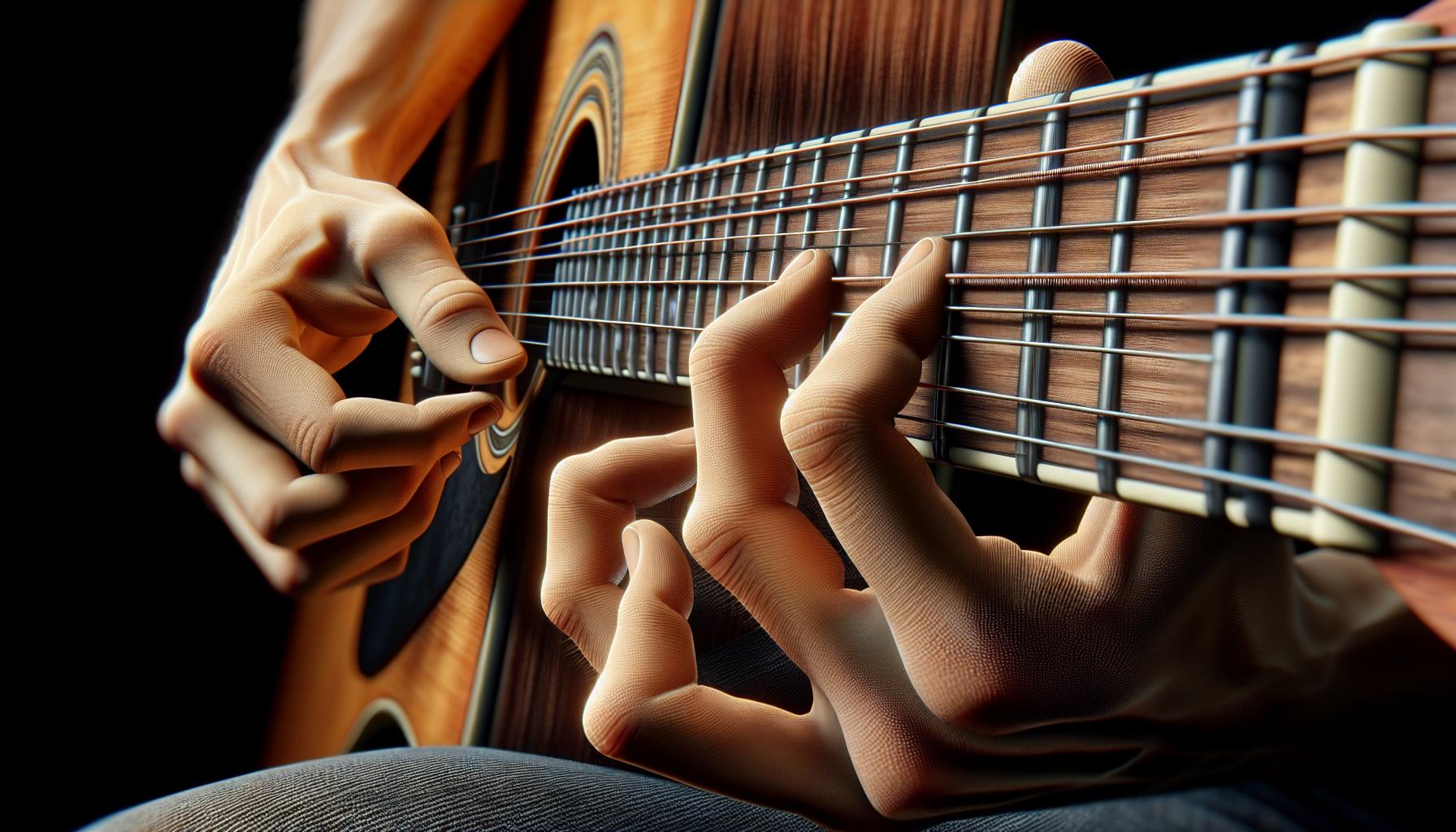Ever wondered why certain chords sound good together, or how to add more depth to your guitar playing? I’m here to demystify the world of music theory for guitarists. It’s not as complex as you might think, and with a little guidance, you’ll be mastering the fretboard in no time.
Understanding music theory can unlock new levels of creativity and expression in your guitar playing. It’s like learning the language of music, allowing you to communicate with other musicians more effectively. Whether you’re a beginner or a seasoned player, there’s always something new to learn in music theory.
Contents
Understanding Music Theory for Guitarists
Think of music theory as the grammar of the music language. It’s the set of principles and conventions that guide the composition, understanding, and performance of music. Who’d want to babble incoherently on their guitar when they could eloquently express themselves, right?
One common myth is that music theory will stifle your creativity. This couldn’t be further from the truth. Understanding music theory provides you with an expansive toolbox loaded with methods to manipulate melody, harmony, rhythm, and form. In the hands of a novice, these tools might be used awkwardly. As you grow in skill and knowledge, these same tools can be wielded masterfully to craft truly exceptional music.
Unified understanding is another perk of knowing music theory. It’s kind of an international language for musicians. Whether you’re jamming with friends, cooperating with a band, or collaborating with an orchestra, the shared knowledge of music theory enables clear communication.
That doesn’t mean you need to be an expert in music theory to start jamming. From my experience, a basic understanding goes a long way. Start with identifying notes on the fretboard, understanding scales, and grasping chord structures. As you get these basics down, you can start exploring more complex concepts like chord progressions, modal playing, and the construction and use of arpeggios. And remember, music theory isn’t just dry, academic knowledge. It’s practical. It’s immediately applicable to your guitar-playing skills – make sure to put everything you learn into practice.
| Element | Description |
|---|---|
| Notes | The building blocks of music. |
| Scales | Patterns of notes, typically 5-7 in sequence |
| Chord Structures | How notes come together to create harmony |
I know the guitar fretboard can seem daunting. It’s like a giant grid with endless possibilities. But, when we break that fretboard down using music theory, it starts to make sense. You’ll see that it’s not just a collection of independent strings and frets, but a interconnected system. Trust me, once you start to comprehend this, you’ll unlock a whole new level of creativity and expression in your guitar playing.
The Importance of Music Theory in Guitar Playing

Let’s delve into the real-world application of music theory in guitar playing. It’s not about rote learning facts and rules, it’s about developing tools to widen your creative horizon and deepen your understanding of music.
When you’re aware of the basic structures of notes, scales, and chords, your fingers start ‘thinking’ in musical terms, not just fret numbers. This knowledge gives you the roadmap to navigate the guitar fretboard, a task that often seems intimidating at first. Your solos, improvisations, and compositions become a deliberate and calculated representation of your musical ideas, rather than a hit-and-miss outcome of trial and error.
Communicating ideas effectively with other musicians becomes a walk in the park when you’ve a solid understanding of music theory. It’s like learning a universal language. Without adequate vocabulary and grammatical rules, sentences are mere sounds with no meaning. Similarly, communicating music ideas without the essence of music theory results in ambiguity and misunderstanding, robbing music of its intended beauty.
Take the dominant seventh chord, for example. It’s a staple in blues and jazz genres and brings a unique tension-release dynamic into play. Dominant seventh chords create a compelling pull towards the following chord, often the root chord, in a progression. Now, if you intuitively know that it’s made up of a major triad and a flattened seventh, you can find different ways to express it on the fretboard, enriching your performances with more tonal varieties.
So, get started on music theory. Master the language of music, unlock your guitar’s fretboard, and open doors to unseen levels of creativity. The theoretical groundwork makes your guitar journey smoother and more fruitful.
The Basics: Notes, Scales, and Intervals

Starting with the most basic building block of music, notes are the fundamental units of sound that our ears pick up. A good grip on the concept of notes and their positions on the fretboard is crucial for every guitarist.
The musical alphabet comprises seven notes: A, B, C, D, E, F, and G. There’s a lot to uncover within these seven notes, as they are just the tip of the iceberg.
Intervals are the heart of music theory as well. They’re the distance between any two notes on your fretboard. Understanding intervals enhances the ability to create catchy melodies and harmonies without relying on guesswork.
Scales, on the other hand, are consequences of intervals. Essentially, a scale is just a series of intervals. Common scales we guitarists use include:
- Major scales
- Minor scales
- Pentatonic scales
- Blues scales
Common questions that arise like “what makes a minor scale minor”, or “why does the blues scale sound bluesy,” are addressed by understanding the intervals that construct these scales.
Can you see already how intricately these three elements intertwine? It’s not a collection of isolated facts, but rather an interconnected system that enhances your musical understanding and creativity. Learn these concepts well, and the fretboard will light up in ways you’ve never seen possible before.
Chords: Building Blocks of Music

Let’s dive right into the world of chords, the building blocks of music. They hold an essential place in music theory and notably, in guitar music theory. Without a grasp of chords, your journey on the fretboard might be kind of a tough ride.
So, what exactly is a chord? A chord is a group of notes, typically three or more, played at the same time. To create a chord, you start with a root note and then add other notes from the scale. This process centers on intervals which we talked about earlier. It’s these combinations that give us a wide variety of chords to use in music, and understanding them can make your guitar playing more enriching and versatile.
One can’t talk about chords without talking about major and minor chords. These are the two most fundamental types of chords. A major chord is generally bright and happy, while a minor chord has a darker, more melancholic feel. The difference between them rests in the intervals used.
You may wonder how many chords are there? Well, the answer isn’t straightforward. But consider this: With just the basic major and minor chords in their standard forms, there are already 24 chords right off the bat! That’s not even considering inversions and extended chords like 7ths and 9ths.
That can seem overwhelming at first, but don’t worry. Mastery is not about knowing every single chord but about understanding how they are constructed and how to use them effectively in music. Learning chords will unlock new dimensions to your guitar playing, allowing for more creativity and broader musical expression.
Alright, now you’re geared up with understanding of chords and their implications in music. So let’s put this theory to work! Picking up your guitar and playing around with chords is the best way to understand and get comfortable with them. Try building simple major and minor chords and then moving on to more complex ones. Embrace the process! This will open up a world of possibilities on your fretboard, deepening your musical journey as a guitarist.
Harmony and Progressions for Guitarists
Picking up from chords, let’s delve deeper into the world of harmony and progressions. Harmony, in simple terms, is the combination of simultaneously sounded musical notes to produce chords and chord progressions. If you’ve got a good grip on chords, you’re well on your way to understanding harmony.
Harmony isn’t something to fear. It’s more of an exploration, an adventurous part of your musical journey. In guitar playing, we use harmonic approaches to give a piece its emotional nuance. A happy song may use major chords while a sorrowful ballad might lean on minor chords. The major-minor distinction is just the tip of the harmony iceberg in guitar music theory.
A crucial part of harmony is chord progressions. You may have noticed certain patterns in the songs you’ve played – chords seem to follow each other in a specific sequence. That’s a chord progression.
Want to hear one of the most popular chord progressions in action? Pick up your guitar and play C Major, G Major, A Minor, and F Major in sequence. Congratulations! You’ve just played the ubiquitous “I-V-vi-IV” progression.
To emphasize the importance of chord progressions in music, let’s put it this way – they’re the narrative of your song. They guide the melodic elements and give your music a sense of direction. They’re not just random groups of chords thrown together but curated sequences that create tension and release, turmoil and calm.
Table 1: Common Chord Progressions in Rock and Pop Music
| Progression Name | Progression Notes |
|---|---|
| I-IV-V | G-C-D |
| ii-V-I | Dm-G-C |
| I-vi-IV-V | C-Am-F-G |
| vi-IV-I-V | Am-F-C-G |
From blues to rock, pop to punk, you’ll hear these progressions (Table 1). The chords may change but the underlying harmony remains the same. Understanding this is a huge leap forward in your guitar music theory journey.
Applying Music Theory to Your Guitar Playing
Alright, we’ve touched base on harmony and chord progressions, don’t forget what we’ve gathered up to this point. These are not just fancy terms, they’re practical tools that you can apply directly to your guitar playing. Let’s dive into how you can do that.
We’ve learned that chords form the backbone of a song, setting the tone and guiding the melody. But how do you choose the right one? The first step is understanding key signatures. That’s the group of sharps or flats at the beginning of the music piece, indicating the key the song is in. Once you know the song’s key, you can predict the chords that are likely to show up.
Let’s say we’re playing in the key of G Major. You won’t just see a G-major chord. You’re also going to see C, D, Em, Am, and Bm. These chords form the “family” of chords that sound good together because they’re in the same key.
Next on the list is scale knowledge. Scales are crucial for creating melodies and solos over chords. Scales give us a pool of notes that sound nice together. Try playing a C-major scale. Now try creating a melody using those notes over a C-major chord. Hear how it fits?
Finally, remember chord progressions. That’s the sequence of chords in a song. Try playing an E-minor chord followed by a C-major. That’s a chord progression and understanding it will give you a roadmap of what’s to come. The more chord progressions you master, the more songs you’ll be able to play.
So start applying these music theory concepts to your guitar playing. Experiment with the keys, scales, and chord progressions we’ve explored. I’m confident that it’ll transform your understanding of guitar playing, making it more enjoyable and meaningful. The journey is long but with every step, you’ll uncover new depths.
Conclusion
So there you have it. We’ve delved into the practical side of music theory for guitarists, shedding light on key aspects like key signatures, scales, and chord progressions. It’s clear that these aren’t just abstract concepts, but essential tools for any serious guitar player. The more you grasp these, the better you’ll navigate the fretboard, craft melodies, and jam over chords. It’s not about memorizing rules, but about enhancing your understanding and enjoyment of playing guitar. Now, it’s your turn to experiment with these ideas. Remember, the journey of mastering music theory is a marathon, not a sprint. So take it slow, enjoy the process and watch as your guitar playing reaches new heights.
